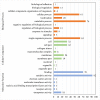Quantitative Proteomics Analysis of Membrane Proteins in Enterococcus faecalis With Low-Level Linezolid-Resistance
- PMID: 30100900
- PMCID: PMC6072972
- DOI: 10.3389/fmicb.2018.01698
Quantitative Proteomics Analysis of Membrane Proteins in Enterococcus faecalis With Low-Level Linezolid-Resistance
Abstract
Despite increasing reports of low-level linezolid-resistant enterococci worldwide, the mechanism of this resistance remains poorly understood. Previous transcriptome studies of low-level linezolid-resistant Enterococcus faecalis isolates have demonstrated a number of significantly up-regulated genes potentially involved in mediation of drug resistance. However, whether the transcriptome faithfully reflects the proteome remains unknown. In this study, we performed quantitative proteomics analysis of membrane proteins in an E. faecalis isolate (P10748) with low-level linezolid-resistance in comparison with two linezolid-susceptible strains 3138 and ATCC 29212, all of which have been previously investigated by whole transcriptome analysis. A total of 8,197 peptides associated with 1,170 proteins were identified in all three isolates with false discovery rate (FDR) at 1% and P < 0.05. There were 14 significantly up-regulated and 6 significantly down-regulated proteins in strain P10748 compared to strains 3138 and ATCC 29212, which were in general positively correlated with transcription levels revealed in previous transcriptome studies. Our analysis suggests that the low-level linezolid-resistance in E. faecalis is conferred primarily by the ATP-binding cassette protein OptrA through ribosomal protection and, possibly, also by the enterococcal surface protein (Esp) and other proteins through biofilm formation. The genetic transfer of optrA is potentially regulated by the surface exclusion protein Sea1, conjugal transfer protein TraB, replication protein RepA and XRE family transcription regulator protein. This report represents the first investigation of the mechanisms of linezolid-resistance in E. faecalis by a quantitative proteomics approach.
Keywords: Enterococcus faecalis; linezolid; low-level resistance; membrane proteins; quantitative proteomics.
Figures





Similar articles
-
Whole transcriptome analysis reveals potential novel mechanisms of low-level linezolid resistance in Enterococcus faecalis.Gene. 2018 Mar 20;647:143-149. doi: 10.1016/j.gene.2018.01.008. Epub 2018 Jan 8. Gene. 2018. PMID: 29325735
-
Resistance mechanisms of linezolid-nonsusceptible enterococci in Korea: low rate of 23S rRNA mutations in Enterococcus faecium.J Med Microbiol. 2017 Dec;66(12):1730-1735. doi: 10.1099/jmm.0.000637. Epub 2017 Nov 7. J Med Microbiol. 2017. PMID: 29111969
-
A high incidence and coexistence of multiresistance genes cfr and optrA among linezolid-resistant enterococci isolated from a teaching hospital in Wenzhou, China.Eur J Clin Microbiol Infect Dis. 2018 Aug;37(8):1441-1448. doi: 10.1007/s10096-018-3269-8. Epub 2018 Jun 16. Eur J Clin Microbiol Infect Dis. 2018. PMID: 29909468
-
The emerging problem of linezolid-resistant enterococci.J Glob Antimicrob Resist. 2018 Jun;13:11-19. doi: 10.1016/j.jgar.2017.10.018. Epub 2017 Oct 31. J Glob Antimicrob Resist. 2018. PMID: 29101082
-
Treatment options for vancomycin-resistant enterococcal infections.Drugs. 2002;62(3):425-41. doi: 10.2165/00003495-200262030-00002. Drugs. 2002. PMID: 11827558 Review.
Cited by
-
Dihydroartemisinin abolishes cisplatin-induced nephrotoxicity in vivo.J Nat Med. 2024 Mar;78(2):439-454. doi: 10.1007/s11418-024-01783-5. Epub 2024 Feb 14. J Nat Med. 2024. PMID: 38351420
-
Antibiotic Resistance Diagnosis in ESKAPE Pathogens-A Review on Proteomic Perspective.Diagnostics (Basel). 2023 Mar 7;13(6):1014. doi: 10.3390/diagnostics13061014. Diagnostics (Basel). 2023. PMID: 36980322 Free PMC article. Review.
-
Emergence of optrA-Mediated Linezolid Resistance in Enterococcus faecium: A Molecular Investigation in a Tertiary Hospital of Southwest China from 2014-2018.Infect Drug Resist. 2022 Jan 4;15:13-20. doi: 10.2147/IDR.S339761. eCollection 2022. Infect Drug Resist. 2022. PMID: 35018102 Free PMC article.
-
Molecular Characteristics and Quantitative Proteomic Analysis of Klebsiella pneumoniae Strains with Carbapenem and Colistin Resistance.Antibiotics (Basel). 2022 Sep 30;11(10):1341. doi: 10.3390/antibiotics11101341. Antibiotics (Basel). 2022. PMID: 36289999 Free PMC article.
-
Synergistic Combination of Linezolid and Fosfomycin Closing Each Other's Mutant Selection Window to Prevent Enterococcal Resistance.Front Microbiol. 2021 Feb 9;11:605962. doi: 10.3389/fmicb.2020.605962. eCollection 2020. Front Microbiol. 2021. PMID: 33633692 Free PMC article.
References
-
- Brenciani A., Morroni G., Vincenzi C., Manso E., Mingoia M., Giovanetti E., et al. (2016). Detection in Italy of two clinical Enterococcus faecium isolates carrying both the oxazolidinone and phenicol resistance gene optrA and a silent multiresistance gene cfr. J. Antimicrob. Chemother. 71 1118–1119. 10.1093/jac/dkv438 - DOI - PubMed
LinkOut - more resources
Full Text Sources
Other Literature Sources
Molecular Biology Databases

